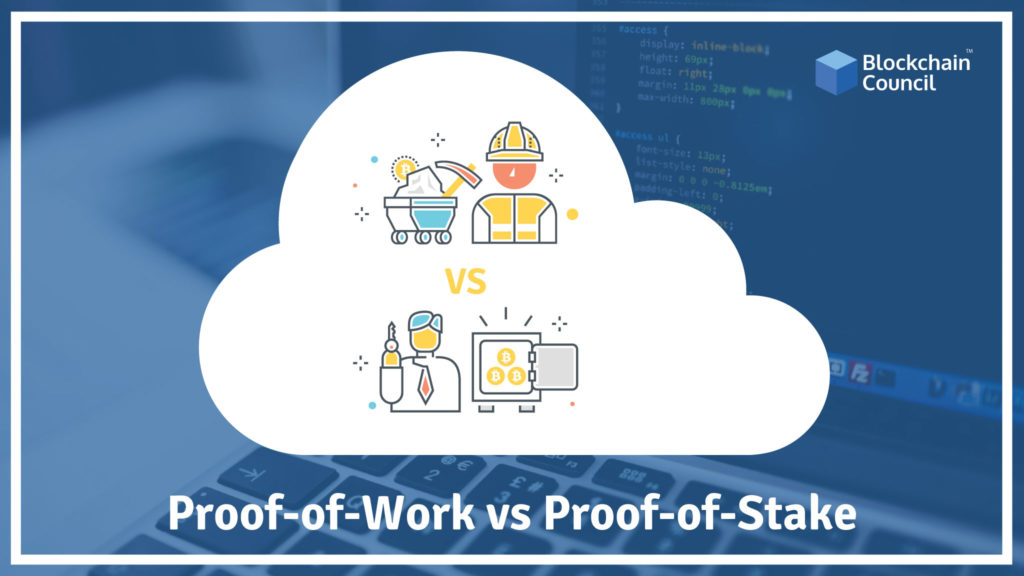
- Toshendra Kumar Sharma
- February 05, 2018
Cryptocurrencies, one of the most searched words on any search engine has something more to it. In this blog, I will be highlighting about Proof-of-Work and Proof-of-Stake. What is the difference between the two and brief overview on the same? Before getting into the details of PoW and PoS, let’s understand quickly about mining.
What is Mining?
Mining is a popular term when it comes to Cryptocurrency and is an integral part of it. It involves two functions:
1) Securing and Verifying – Adding the transactions to the Blockchain
2) Releasing new Currency
This process requires a computer and a unique program which helps the miners compete with their contemporaries in solving complex mathematical problems. It means that the miners need huge computers and resource.
What is the purpose of Mining?
Mining solves two purposes:
1) It verifies the legitimacy of transaction thus avoiding double-spending.
2) Creating new digital currencies by rewarding the miners for profiling their previous task
In simple words, mining is a validation of transaction or block involving processing of complex algorithm. Let me try to put it in simpler words, supposes a transaction takes place in a coin network, say Bitcoin transaction, the miners having more computing power and computers would be able to authenticate the transaction faster than the others and thus may earn reward in the form of altcoins.
Proof of Work(PoW):
As the name itself indicates, Proof-of-Work means validation of work that happened and prove that it is correct. Many altcoins follow this way of consensus ensure the authenticity of the chain.
I would try to simplify this in simple words:
Suppose you are solving a math problem and you along with your batchmates are solving it. Amongst all the students who attended the problem, the one who not only comes with the correct answer but at the same time also illustrates the steps to approach the problem gets the reward. This whole process requires a lot of hard work and effort.
Now I will replicate the same to cryptocurrency. Let’s say that the cryptocurrency network, the transaction is a math problem, the cryptocurrency network is the classroom, and the computing hardware and software are the students, and the brain power of the students are computing power.
It would have simplified the concept to you. The miners with better hardware and software skills to solve the problem to get the rewards as compared to those who don’t have it.
Although PoW has its positive side, it does have some downside :
You need high electric power which may increase the cost for the miner
More efficient computing power regarding hardware which again adds to the cost
With more and more coins coming in the market, the miner’s reward may come down as the coins become scarce.
Proof of Stake(PoS):
It is another popular way of validating a transaction. However, PoS works differently as compared to PoW. In this form of validation, it will pick the validator which is known as a miner in PoW based on the coins the validator has and the age of the same. Age here means how long you have the coin.
Let’s take an example, you have 100,000 altcoins in a wallet. These coins will have an age attached to it which states for you long you have had it. Now, these 100,000 altcoins are at stake. If you move these coins from one wallet to another, the aging gets reset. PoS means that a person can mine or validate a transaction based on the number of coins held by the person. It means the miner is having more altcoins have more power.
How did PoS come into existence?
The origin of PoS goes to the drawbacks of PoW which I will explain further. But, first, let’s understand what happens when the transaction in the cryptocurrency world starts off. When the transaction has initiated the data for the same is fitted into a block. This block has the maximum capacity 1 megabyte which is them duplicated on different computers or what we call as nodes. Nodes are the administrative body.
The nodes work as the administrative body which screens the legitimacy of the block. To do the verification, the miners have to solve an algorithm as mentioned above. The first miner who can solve the puzzle or decrypt the block gets rewarded with a coin. After verification, the block gets added to the Blockchain and is visible in the ledger.
Mining is a tedious task and requires a lot of computer power to perform cryptographic calculations and to solve the computational puzzle. This computing power requires a vast amount of electricity. Did you know that in 2015, one Bitcoin transaction consumed power equivalent to the power consumed by 1.57 American household per day?
The PoS or Proof of Stake addresses this issue. It gives the mining owner to the one who has more number of coins. By going this way, the utilization of energy for solving PoW puzzle get cuts down by the PoS.
To sum up, PoS eliminated the following hurdles of PoW:
1) It cuts down the need to have the expensive
2) PoS is energy efficient as compared to PoW.
3) It eliminated the below challenges from PoW and believed to have an advantage
4) Fast and quick validations
Although the differences go much more in-depth, I am sticking to the ones which provide a higher level of differences.
The bottom line
The PoS or the Proof of Stake system doesn’t work alone, without mining you cannot create a community of coins. Most of the coins adopt a mix of both PoS and PoW. For example, Bitcoin and Litecoin used PoW system whereas Nxt Coins used the PoS method. Coins like Peercoin makes use of both PoS and PoW. It is expected that Ethereum will switch from PoW to PoS system.




































































 Guides
Guides News
News Blockchain
Blockchain Cryptocurrency
& Digital Assets
Cryptocurrency
& Digital Assets Web3
Web3 Metaverse & NFTs
Metaverse & NFTs
